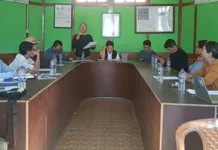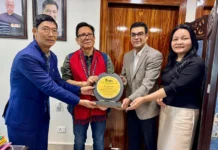TribalBookworms
[ Dr Doyir Ete ]
Lummer Dai’s novel Bride Price brings literary expression to the traditional practice of bride price exchange in tribal societies, examining this age-old custom through a modern lens. A pioneering literary figure in Arunachal Pradesh, Dai was also a journalist and a social activist. Yet, today, it is as a writer that his legacy mostly endures. Originally published in 1978 as Kanyar Mulya in Assamese, Bride Price was later translated into English by Jogendra Nath. The novel captures a period of transition during the early periods of transformation of the state, like the advent of modern education, shifts in social customs, and the status of women, and the youths of the time. Dai’s keen insight into these transformations makes the novel feel set in a past that is both distant and intimately familiar. It is a novel that continues to resonate even today, particularly in its depictions of the social strictures of our society.
The novel carries its own history. After its publication, it gained wide popularity, particularly in Assam, and came to be regarded as a novel about Adi society. This perception likely came from the fact that, in the past, the Adi encompassed multiple sub-tribes, including the Galo. Also perhaps, Lummer Dai’s own identity as an Adi writer may have contributed to this broader recognition. However, given the evolving nomenclature and distinct identity of the Galo tribe over the years, it becomes necessary to approach these aspects with clarity, especially when engaging with the novel in classrooms, academic discussions, and within its larger historical and cultural context. Several elements within the story affirm this connection: the names of characters, descriptions of family structures, the village setting, rituals, and other cultural details. These aspects subtly indicate that Dai was depicting the Galo society, even as the novel has often been understood in a more generalised tribal context. At its core, the novel explores the practice of bride price, a tradition that, in some form, continues to persist even today.
As the title suggests, the novel’s central theme revolves around the practice of bride price, explored through the character of Gumba. A young girl studying in Class 12, Gumba is unaware that she was betrothed as an infant to Dakto, a boy from another village. At the time of their engagement, she was only three years old, while he was ten. Her father, Kagum, now feels that he has indulged her long enough and that it is time for her to be sent to her in-laws’ house. He believes that education will not amount to much for her, as her ultimate duty is to care for her husband’s household. Another concern for him is that he has already spent most of the bride price he had received, which included multiple mithuns, cows, cash, and bowls, and now he feels compelled to fulfil the marriage arrangement.
The story follows Gumba’s rejection of the marriage and her resilience in the face of torture and humiliation. Lummer Dai writes with empathy while skilfully presenting multiple perspectives. The father, for instance, is portrayed as a typical patriarchal figure deeply rooted in traditional values, which he rarely questions. He upholds traditions and customs, even at the cost of material loss, placing name and reputation above all else. His love for his daughter is evident, yet it does not override his adherence to these customs, which he considers a father’s natural right. However, his transformation by the end, his eventual support for Gumba as she resists oppressive social norms suggests that even staunch traditionalists are capable of change.
A strength of the novel is also its depiction of the youths, who emerge as powerful voices. However, many elders in the story view them as disruptors who attempt to uproot age-old practices. However, for the author, they represent the future leaders, and agents of change capable of transforming traditional society through education.
From the time represented in the novel to the present day, our state has undoubtedly transformed. Women have progressed in different spheres and society has benefitted much from it. However, having recently attended a traditional marriage, I found myself reflecting on certain observations that have stayed with me. These are merely reflections, not an attempt to moralise or dictate; in fact, far from it, I am grappling with these thoughts myself. In many ways, traditions have evolved, while some rituals have been modernised, others have become more rigid – all in an effort to uphold the authenticity of our forefathers. However, times have changed, and values have shifted, especially in economic terms. As Minjum, the teacher in the novel Bride Price states “The old days are no more.” My concern particularly lies with the practice of the exchange of brass items and beads. Today, arbitrary values are assigned to these items, ranging from a few thousand rupees to lakhs, and even as high as crores. The more antique, the more expensive. How practical and rational is this? Some parents spend a fortune buying these items in keeping with tradition, while others buy them as gifts because customs demand them.
I am all for preserving tradition but within reasonable limits. These items, readily available in the markets of Assam, are often crudely made to appear antique. With every sale, the shopkeepers’ pockets grow heavier. Yet, they are not made of precious metals or rare beads. Instead of spending a fortune on these items for ritualistic exchange, imagine investing the same amount in gold, silver, diamonds or land. Wouldn’t that be more valuable for a daughter or even a son? Such assets could serve as financial security; she could pawn them in times of emergency or even use them as collateral for loan.
There is not a bank in our state — or anywhere else, for that matter — that would lend a single paisa against traditional beads or brass items. They hold no mortgage value outside our cultural sphere, nor will any insurance company provide coverage for them. In today’s world, is it practical to keep hoarding these items? At the wedding I recently attended, I, too, received a brass plate and a string of beads. They were beautiful and perhaps valuable in a cultural sense, but what practical use do they serve? I cannot eat from the plate, nor do I have any other purpose for it. It now sits in a corner of my almirah, gathering dust and turning grey. While I do cherish the beads I possess, their use is limited to special occasions. For such events, I agree that one should have a few according to need. As I said, I respect tradition, but it must be practised within reasonable limits. Certain customs place a heavy burden, especially on the bride’s family, particularly during marriage. A symbolic exchange of items, upheld for the sake of tradition, would be a far more reasonable approach – tradition would be maintained while easing financial strain. Instead of enriching shopkeepers in Assam, why not invest in something more valuable that genuinely benefits our children?
Through this article, I urge community bodies to reflect on these aspects and make these practices more sustainable. We must retain the best aspects of tradition while ensuring that our daughters receive something that provides them security in times of need. Perhaps, like Lummer Dai understood, times are changing — and so should our mindset. (Dr Doyir Ete is Associate Professor, Dept of English, RGU, and a member of the APLS and Din Din Club.)




